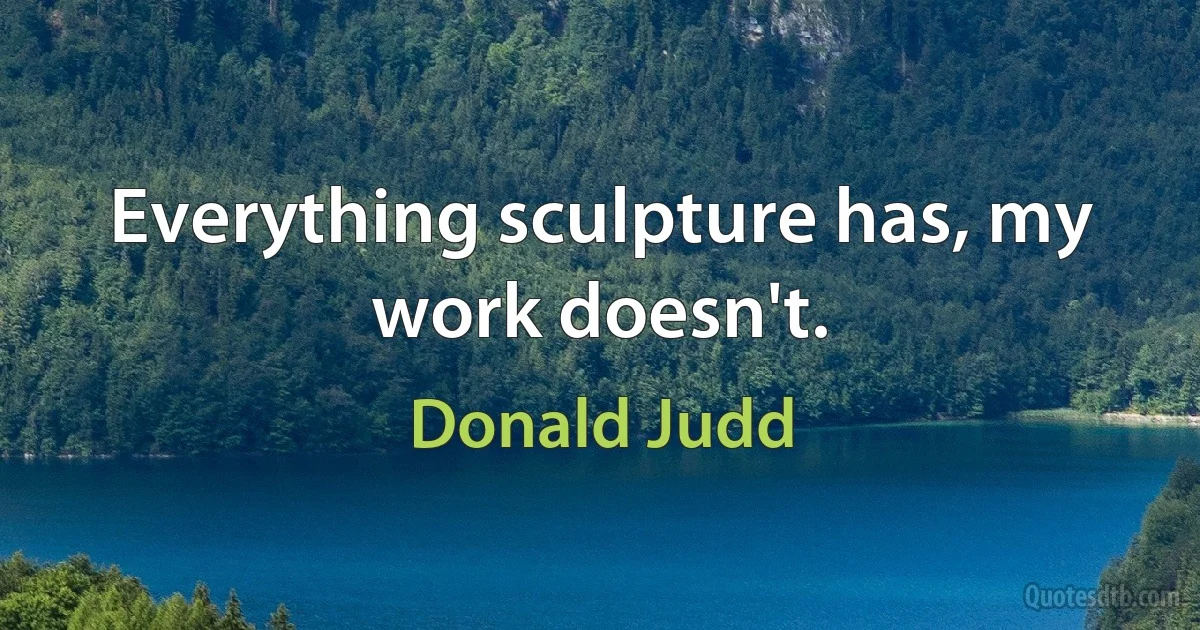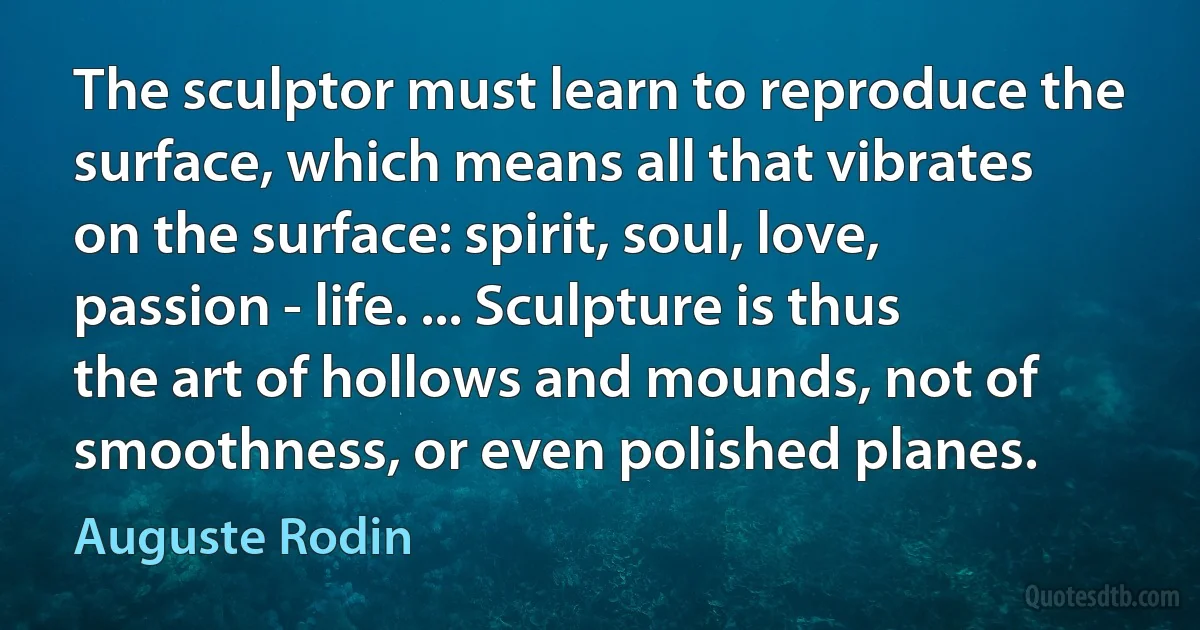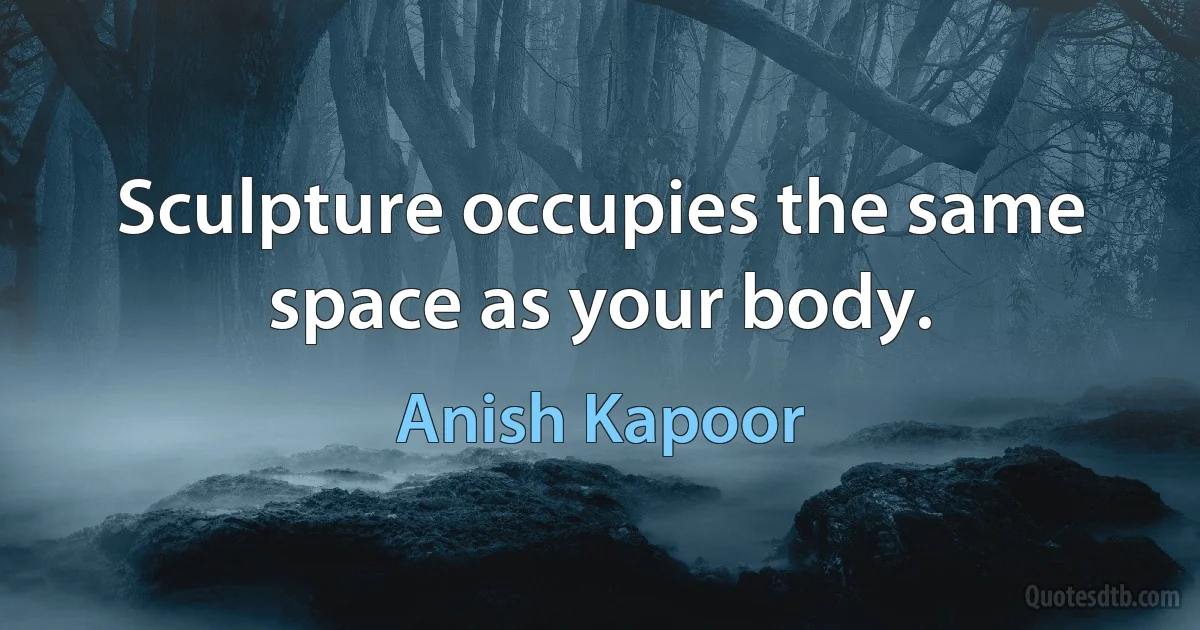Sculpture Quotes - page 6
The good taste we speak of, which is that of literature, is not limited to what we call the sciences, but extends itself imperceptibly to other arts, such as architecture, painting, sculpture, and music. 'Tis the same discerning faculty which introduces universally the same elegance, the same symmetry, and the same order in the disposition of the parts; which inclines us to a noble simplicity, to natural beauties, and a judicious choice of ornaments. On the other hand, the depravation of taste in arts has been always a mark and consequence of the depravation of taste in literature. ... The good taste of literature reaches also to public customs, and the manner of living. An habit of consulting the best rules upon one subject, naturally leads to the doing it also upon others.

Charles Rollin
Women have been discouraged from genres such as sculpture that require studio training or expensive materials. But in philosophy, mathematics, and poetry, the only materials are pen and paper. Male conspiracy cannot explain all female failures. I am convinced that, even without restrictions, there still would have been no female Pascal, Milton, or Kant. Genius is not checked by social obstacles: it will overcome. Men's egotism, so disgusting in the talentless, is the source of their greatness as a sex. [...] Even now, with all vocations open, I marvel at the rarity of the woman driven by artistic or intellectual obsession, that self-mutilating derangement of social relationship which, in its alternate forms of crime and ideation, is the disgrace and glory of the human species.

Camille Paglia
All you can usually say about a poem or a picture is, 'Look at it, listen to it.' Whether you listen to a piece of music or a poem, or look at a picture or a jug or a piece of sculpture, what matters about it is not what it has in common with others of its kind, but what is singularly its own."

Basil Bunting
Take more room, examine my 'Gate' from a little farther off, and you will see once more the effect of the whole - the effect of unity which charms you when it is deprived of its ornamentation. You must understand that my sculpture is so calculated as to melt into the principal masses. For that matter, it completes them by modeling them into the light. The essential designs are there: it is possible that in the course of the final work I may find it necessary to diminish such or such a projection, to fill out such or such a pool of shadow; nevertheless, leave this difficulty to my fifty years of artisanship and experience, and you may be sure that quite by myself I shall find the best way of finishing my work.

Auguste Rodin
Yes, they are beautiful... The shirt, the blouse are garments the folds of which yield simple planes and effects that, rightly rendered, are those of true sculpture. But there is something better still, and that is sackcloth. If I had clothed my 'Burghers of Calais' in sackcloth, they would certainly be more beautiful. I did not dare to. Some one else will do this and will succeed. It is sufficient to express an idea and leave it to its destiny.

Auguste Rodin
From the very beginning of the Constructivist Movement it was clear to me that a constructed sculpture, by its very method and technique brings sculpture very near to architecture... My works of this time up to 1924.... are all in the search for an image which would fuse the sculptural element with the architectural element in one unit. I consider this Column the culmination of that search.

Naum Gabo
More often than not, [people] expect a painting to speak to them in terms other than visual, preferably in words, whereas when a painting or a sculpture needs to be supplemented and explained by words it means either that it has not fulfilled its function or that the public is deprived of vision.

Naum Gabo
Being an artist now means to question the nature of art. If one is questioning the nature of painting, one cannot be questioning the nature of art. If an artist accepts painting (or sculpture) he is accepting the tradition that goes with it. That's because the word art is general and the word painting is specific. Painting is a kind of art. If you make paintings you are already accepting (not questioning) the nature of art. One is then accepting the nature of art to be the European tradition of a painting-sculpture dichotomy.

Joseph Kosuth
Well sure, my sculptures are floor pieces. Each one, like any area on the surface of the earth, supports a column of air that weighs – what is it? – 14.7 pounds per square inch. So in a sense, that might represent a column. It's not an idea, it's a sense of something you know, a demarked place. Somehow I think I always thought of it going that way, rather than an idea of a narrowing triangle going to the center of the earth... I have nothing to do with Conceptual art [in contrast to his Physical Art, as Carl Andre called his sculpture art already in 1969]]. I'm not interested in ideas. If I were interested in ideas, I'd be in a field where what we think in is ideas... I don't really know what an idea is. One thing for me is that if I can frame something in language, I would never make art out of it. I make art out of things which cannot be framed in any other way. [quote from a talk with the audience, December 1969].

Carl Andre
I've been educated in some pretty lively barrooms, like the Cedar Bar in New York. And I went to high school with Frank Stella and when he got out of college he went to New York and started painting... I was working with sculpture in a kind of dilatory way, and he said to come up and work in his tiny loft when he wasn't there. At the same time I sort of dabbled in a little bit of painting, and a kind of confusion. I was an eye, ear, nose, and throat person too... One day Frank Stella just said to me, 'Look, if you paint another painting I'm going to cut off your hands.' I asked, 'Can't I become a good painter?' Frank said, 'No, because you are a good sculptor now.' That's really my formal education.... the company of artists is the great education. We educate each other. I've learned from older, wiser people by the old Greek method of sitting down and drinking with them. And that's how I received my education.

Carl Andre
In the years when I was trying to get my work shown and accepted and so forth, I went to work for the Pennsylvania Railroad and that was my formal art school. You can learn a hell of a lot about sculpture, working in a railroad. The thing about getting a job outside of art is the fact that you can finds out whole areas of materials. I don't mean new ones. I mean old ones like scrap iron. A railroad is essentially a big collection of scrap iron, and that's why it's great. You get out and beyond the art confine.

Carl Andre
I am interested in sculpture that manipulates the viewer into a specific relation with both space and time. Time, on two levels; one narratively and cinematically as a matter of the passage through the work, and the other as a literal elongation of the moment. This has to do with form and colour and the propensity of colour to induce reverie. Consequently, I hope, an elongation of time. Space is as complex, the space contained in an objectmust be bigger than the object which contains it. My aim is to separate the object from its object-hood.

Anish Kapoor
Proportion applies to sculpture as to painting; perspective determines the contour; chiaroscuro gives relief through the disposition of lights and shadows in their relationship with the background; color gives the appearance of life.. .The colorists, the men who unite all the phases of painting, have to establish, at once and from the beginning, everything that is proper and essential to their art. They have to mass things in with color, even as the sculptor does with clay, marble or stone; their sketch, like that of the sculptor, must also render proportion, perspective effect, and color.

Eugène Delacroix



